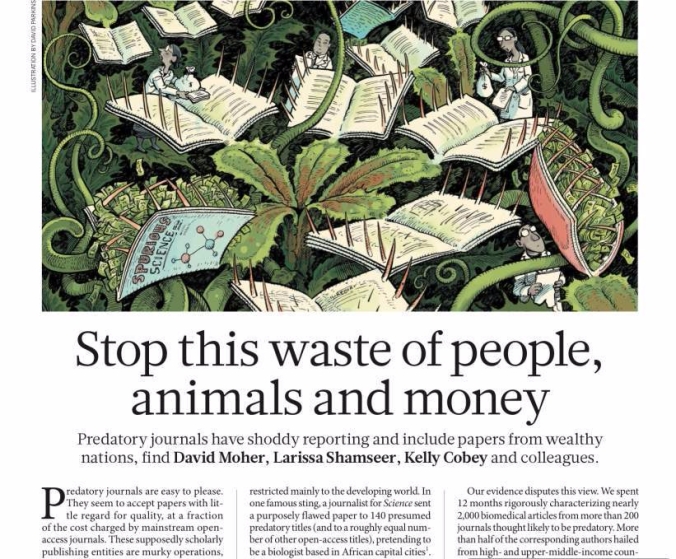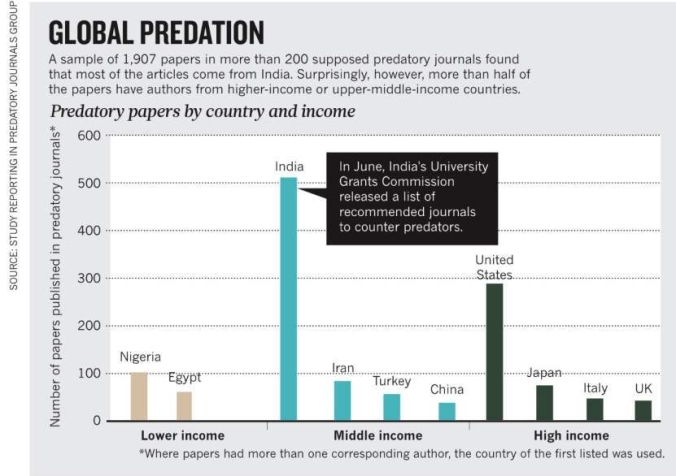
Screenshot of the Comment piece on predatory journals published in Nature.
Twenty-seven per cent of over 1,900 papers published in predatory journals came from researchers based in India. But a large number of scientists in the developed countries too are willing to pay to have their work published in predatory journals.
Contrary to popular belief, 57% of primary biomedical research papers published in predatory journals were from the developed countries. Of the 1,907 papers published in 220 predatory journals, 27% were by researchers based in India, followed by the U.S. at 15%, according to a study published on September 6, 2017 in the journal Nature. The predatory journals were chosen from the University of Colorado, Denver, librarian Jeffrey Beall’s list of “potential, possible, or probable” predatory journals.
“Our findings suggest that the problem of predatory publishing is a global phenomenon that researchers from across the globe from a variety of academic institutions have contributed to,” Larissa Shamseer from the University of Ottawa and one of the authors of the Comment piece says in an email.
Shockingly, researchers from prestigious universities in the U.S. too published in predatory journals. With nine papers, Harvard University in Cambridge, Massachusetts had the highest number of papers published in bogus journals, followed by the University of Texas — 11 papers from all campuses. Researchers from even the Mayo Clinic in Rochester, Minnesota published seven papers in such trash journals.
According to 2017 Institute for Democracy and Economic Analysis (IDEA) study by Machacek, V. and Srholec, M., about 15,000 papers from researchers based in the U.S. are published in predatory journals. “Even in countries at the top of the technology ladder, there is a large number of researchers who are willing to pay to have their work published in predatory journals,” Machacek and Srholec write.
India leads the pack
But 27% of over 1,900 papers published in predatory journals came from researchers based in India. The results of the 12-month investigation by a team of researchers led by Dr. David Moher from Ottawa Hospital Research Institute, Ontario, Canada, found that with 20 papers by 14 researchers, D.Y. Patil University based in Mumbai had the most number of papers published in trash journals. Manipal University with 15 papers and nine papers by researchers at Bangalore Medical College and Research Institute were the other highest publishers in predatory journals.

While D.Y. Patil University did not respond to mails sent by the authors, the email sent to Bangalore Medical College and Research Institute bounced back. Manipal University has claimed that following an intervention the number of papers published in predatory journals has “reduced”.
The study found that the papers were “atrocious in terms of reporting”. Only 40% declared receiving ethics committee approval, nearly three-quarters of the papers did not provide information on funding and assessing the risk of bias was abysmally small.
Duped or willing partners?
Considering that researchers from reputed institutions must be aware of respected journals in their field of specialisation, are they publishing in predatory journals knowing fully well its true nature? “Some may be duped into thinking these journals are legitimate. Alternatively, there may be researchers who knowingly publish in these journals. At most academic institutions, the focus of evaluation is on quantity of scientific publications, rather than on their quality. This may be a motivating factor for researchers looking to build the number of publications on their CVs, as predatory journals are known to offer a fast, cheap alternative model of publishing and not vetting research via peer review before it is published,” Shamseer says.
Writing in an accompanying piece, Kelly Cobey, publications officer at the Ottawa Hospital Research Institute in Canada and one of the authors of the Comment piece recalls how a senior scientist at her institute was duped into submitting his paper to a predatory journal. The paper was accepted with minor revisions and the scientist was asked to pay $979 towards publication fees. The fee was never communicated at the time of submission. After cancelling the submission, the scientist submitted the paper to a reputed journal and got it published.
Then came the second jolt. The paper was published by the predatory journal despite the scientist not paying the publication charge. Retracting the paper from the predatory journal was the only way to avoid duplication. But for that the scientist was asked to pay $319, which is unheard of at legitimate journals. The two editorial board members, known personally to the scientist, were of little help as they had never agreed to become editorial board members of the journal in the first place!
For most of the 17% of papers that reported a funding source, the U.S. National Institutes of Health (NIH) was most frequently mentioned one. Yet, the NIH website does not mention if it has any policy or mechanism to monitor whether researchers they have funded have published their work in legitimate or predatory journals.
“Funding agencies, institutions, researchers, publishers, and regulators all have a role to play, ranging from education, training, monitoring, to advocating for better practice when it comes to publishing and sharing research,” Shamseer says.
“A problem largely unknown a decade ago, there are now a roughly estimated 8,000 predatory titles that collectively ‘publish’ more than 400,000 items a year. We need to cut off the supply of manuscripts to these illegitimate outfits,” the authors write.